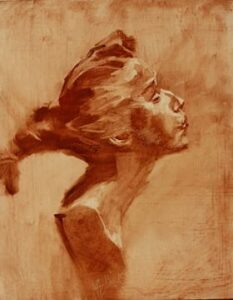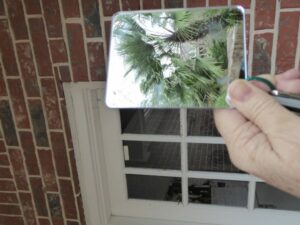 I was a “closet artist” for about 15 years. I had a number of excuses why I couldn’t officially launch my painting career. Family obligations topped my list. But if I had been brutally honest, fear was also a factor. Following are five things I’ve done to help myself break free from the closet.
I was a “closet artist” for about 15 years. I had a number of excuses why I couldn’t officially launch my painting career. Family obligations topped my list. But if I had been brutally honest, fear was also a factor. Following are five things I’ve done to help myself break free from the closet.
JOIN A LOCAL GROUP OF ARTISTS
Three years ago, I joined The Chestnut Group, a non profit alliance of landscape artists and friends dedicated to the conservation and preservation of vanishing landscapes in Middle Tennessee. I had no earthly idea how many new friends I would meet, and how much there was to learn about plein air painting. Painting outside in the natural and changing light is a revelation. This one act of “joining” jumpstarted my curiosity, skills, and most important, my confidence.STEP OUTSIDE OF YOUR COMFORT ZONE
 Warehouse 521, owned and operated by Jeanie Smith, is a local Nashville studio that offers countless opportunities to paint the human form with live models. Painting from life is challenging, and if you’re not used to painting in a group setting, the first few sessions may prove to be a bit daunting. If you haven’t noticed, artists are some of the nicest folks around, and If you do have a disappointing day, there will be plenty of people nearby that have gone through the same frustration. They’ll most likely help you laugh at yourself, offer sound advice, and maybe help you realize that what you’ve got on your canvas isn’t half bad!
Warehouse 521, owned and operated by Jeanie Smith, is a local Nashville studio that offers countless opportunities to paint the human form with live models. Painting from life is challenging, and if you’re not used to painting in a group setting, the first few sessions may prove to be a bit daunting. If you haven’t noticed, artists are some of the nicest folks around, and If you do have a disappointing day, there will be plenty of people nearby that have gone through the same frustration. They’ll most likely help you laugh at yourself, offer sound advice, and maybe help you realize that what you’ve got on your canvas isn’t half bad!
START A CRITIQUE GROUP
My critique group consists of a few of those really nice folks that I mentioned above. We get down and dirty with detailed observation and criticism. Honesty and encouragement prevail. Developing a thicker skin is a must when you’ve tagged yourself as an artist. There will be triumphs and failures to be sure. What better way to glean pertinent information about what you’re doing right, and wrong, than from fellow artists you admire?
ENTER JURIED COMPETITIONS
You win some, you lose some, but if you don’t try, you’ll never win. I have met wonderful artists from all over the country at these competitions and seen stunning paintings that I would have otherwise never seen. Just do it. Pull on your thick skin, and be fearless.
ENJOY THE JOURNEY!
Luxuriate in the process of learning. Ask questions of fellow artists. “What is your process?” “Why are you using this particular color?” We know in our hearts that we are in this creative process for the rest of our lives, and aren’t we lucky?
The goal is not to be superior to others, but to be superior to our former selves.
– Ernest Hemingway
Tell me what it is you plan to do with your one wild and precious life?
– Mary Oliver

 Denver is a great case study to understand the general health of representational art. Several well-known galleries in the area including Saks Gallery and Abend Gallery have been in business for many years and are credible institutions with solid reputations. Their exhibition openings are well-attended and feature art that depicts realistic subject year-round. Knowing this, I feel reassured again that the state of representational art was alive and well. However, there are more than 100 art galleries in the Mile High City, and looking at the bigger picture, it seems that there are fewer galleries that promote representational works than those that promote other genres. For example, the River North Art District (RiNo) almost exclusively promotes non-representational works. Maybe it’s not about the quantity of representational art galleries that indicates whether or not the genre is dying. A deeper look into art history reveals some interesting trends too.
Denver is a great case study to understand the general health of representational art. Several well-known galleries in the area including Saks Gallery and Abend Gallery have been in business for many years and are credible institutions with solid reputations. Their exhibition openings are well-attended and feature art that depicts realistic subject year-round. Knowing this, I feel reassured again that the state of representational art was alive and well. However, there are more than 100 art galleries in the Mile High City, and looking at the bigger picture, it seems that there are fewer galleries that promote representational works than those that promote other genres. For example, the River North Art District (RiNo) almost exclusively promotes non-representational works. Maybe it’s not about the quantity of representational art galleries that indicates whether or not the genre is dying. A deeper look into art history reveals some interesting trends too. Art history tells us there are times when certain art forms and styles are more popular. In the late 1800’s, traditional artists had to eventually yield to newer impressionists. After this, post-impressionists dominated the art scene. Expressionists gained popularity, and later came the abstract expressionists… and so on. Judging by history, we know there are cycles in the styles of art and what appeals to society. But we also know that even with all the small changes and larger epochal shifts in artistic styles, representational art has never truly gone away. It may have been less popular during certain periods, but there is plenty of good evidence (in the form of very good paintings) that representational art is not dead.
Art history tells us there are times when certain art forms and styles are more popular. In the late 1800’s, traditional artists had to eventually yield to newer impressionists. After this, post-impressionists dominated the art scene. Expressionists gained popularity, and later came the abstract expressionists… and so on. Judging by history, we know there are cycles in the styles of art and what appeals to society. But we also know that even with all the small changes and larger epochal shifts in artistic styles, representational art has never truly gone away. It may have been less popular during certain periods, but there is plenty of good evidence (in the form of very good paintings) that representational art is not dead.









 The MVP makes capturing the essence of a rapidly-changing scene much easier by literally framing and filtering it down to a wonderful design. I spent about an hour on the whole plan, including the strategy sketch and the transfer to my canvas. It’s amazing how much more smoothly the painting process goes when you have confidence in the plan and structure that underlies it. Having the right tools to simplify our job will go a long way toward the creation of stronger paintings.
The MVP makes capturing the essence of a rapidly-changing scene much easier by literally framing and filtering it down to a wonderful design. I spent about an hour on the whole plan, including the strategy sketch and the transfer to my canvas. It’s amazing how much more smoothly the painting process goes when you have confidence in the plan and structure that underlies it. Having the right tools to simplify our job will go a long way toward the creation of stronger paintings.
